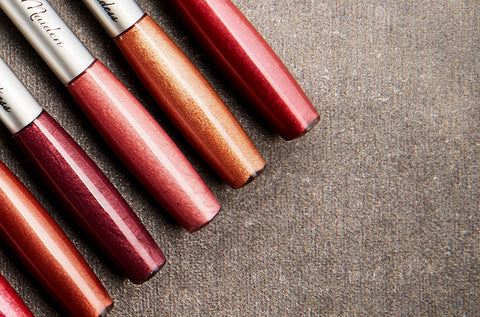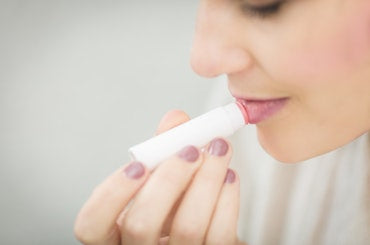Is Your Traditional Lip Gloss Poisoning You? Find Out What Lipstick Is Made Of

When nutritionists and doctors tell us to eat only natural ingredients, and to avoid ingredients you can’t pronounce—take a moment to think what is in your lip gloss.
Unknown to most consumers not using natural lip makeup, the chemical based lip gloss products they purchase contain unpronounceable names that can contain ingredients that are not only unnatural but may cause health problems. Natural lip gloss products are the safe, better alternative.
Here are some of the worst chemicals that may be found in lip gloss:
Lanolin Oil & Hydrogenated Lanolin
These ingredients are extracted from the sweat glands of sheep in order to keep water from penetrating their wool. Topically, this ingredient is okay but when ingested can cause diarrhea. Another ingredient to mention is Isopropyl Lanolate— which is also made from wool as a thickener.
Polybutene and microcrystalline wax are used in cosmetics as binders to increase the viscosity of a product. Both ingredients are classified in the Environment Canada Domestic Substance List as toxic or harmful with a medium human health priority in relation to organ system toxicity. The Cosmetic Ingredient Review Assessments have strong evidence that Polybutene is a human irritant for products used around the eyes, on the skin, or aerosolized. It is interesting to note that Polybutene is commonly used as an airplane adhesive.
Ethylhexyl Palmitate
Ethylhexyl palmitate, also known Isopropyl palmitate or Octyl palmitate, is derived from Palm oil as a natural replacement to Silicone. Although, this ingredient is deemed natural—the harvesting practices by major palm oil suppliers destroy our beloved rainforests and put creatures that rely on this tree and it’s fruit at risk. Did we also mention that it clogs your pores, irritates your skin, and may cause dermatitis?
Isopropyl Myristate
This synthetic oil is another thickening agent—with the purpose of moisturizing skin. According to the Environment Working Group’s Skin Deep Database, it’s highest concern is irritation when applied onto the skin. This irritation may pave the way for other chemicals in your products to cause severe irritation.
Ceresin
Considered to be highly toxic, this mineral wax is made from coal to be used as an emollient. It has been shown to cause cancer in animals when ingested.
Propylparaben
Parabens may be considered the most harmful ingredients on the market. Unfortunately, you can find parabens listed in many foods. Propylparaben is an endocrine-disrupting chemical which leads to infertility in both men and women. It is also linked to accelerating the growth of breast cancer cells. Make sure this ingredient is not listed in your deodorant. See our blog on natural deodorants for more information. The FDA considers small amounts safe, but if you consume a small amount from many sources this can build to a significant amount of toxins in your body.
Synthetic Coloring
Synthetic coloring in lip glosses contain heavy metal. Toxic metals include Cadmium, Manganese, Lead, Mercury, and radioactive metals. Metal toxicity depends upon the absorbed dose, the route of exposure, and the duration of exposure (i.e. acute or chronic). Some symptoms of exposure to heavy metals is nausea, vomiting, diarrhea, abdominal pain, anemia, and heart problems.
Synthetic Fragrances
Thousands of synthetic chemicals are used to create modern day fragrances. Some of these chemicals have been linked to health impacts ranging from eye and skin irritation to hormone imbalance and increased risk of breast cancer. Furthermore, these ingredients are kept secret. The vast majority of manufacturers are currently not disclosing fragrance ingredients on websites or on the product label.
How long and how often do we use lip care products?
Considering all the potential toxins found in lip products, it would be wise to choose one that is all natural.
The next time you are in the market for a lip product, think about reaching for natural makeup products. The safer, healthier, and better choice alternative for your lip gloss.
Want more in depth information to different skin care ingredients and how to use them? Check out our new e-book / paperback available on Amazon.com: Your Best Skin Yet: Popular Natural Ingredients In Skincare and How to Use them: A quick guide to common and natural ingredients to formulate skincare at home or in a professional setting.
References:
- UCSB Science Line
- DIRTY DOZEN GUIDE TO FOOD ADDITIVES: GENERALLY RECOGNIZED AS SAFE – BUT IS IT? By Ryan Jaslow
- CBS News TOXIC METALS AND CANCER RISKS FOUND IN LIPSTICKS, LIP GLOSSES WOMEN'S VOICES FOR THE EARTH, OUR HEALTH, OUR FUTURE TOXIC FREE



Hi Sonia,
You can try using Jojoba Gel instead of polybutene.
What natural product can replace polybutene inside lipgloss? I am trying to make nude colors and I want the color to form on the lips but I do not want to use polybutene if I can find a natural product.